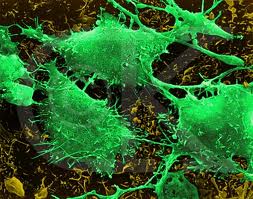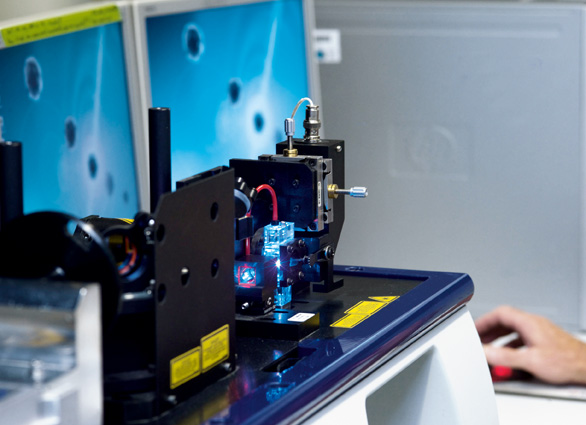Ethical and Social Issues
While cell surface proteins have majorly impacted the biomedical world, some progress has been hotly debated by both scientists and the general public.
 The photo above shows a stem cell being harvested. Stem cells are often recognized by the surface proteins on them. Immunophenotyping The debate around immunophenotyping is significantly less heated than around stem cells. As immunophenotyping is in essence used only to identify diseases through protocols such as cluster differentiation, not many people are opposed to using cell surface proteins to better identify and target malignant cells. As always, however, some are opposed to moving too fast on a new branch of science and possibly inadvertently causing more harm than good. Many proponents of Immunophenotyping, which are the vast majority of the science world, see surface cell markers as an easy, efficient way to deal with diseases such as cancer. In fact, there are many unexpected applications of this easy way to identify cells, such as applications in immunotoxicity studies; for more on this interesting tidbit, see here . [10]  Cell surface markers provide a new set of tools to treat major diseases such as cancer. | Stem Cell Research As any person who even remotely follows the news will know, the stem
cell debate has been escalated into not only a scientific matter, but
also a religious and political one as well. [5,6] Many stem cell research involves the use of cell surface markers to identify specific stem cells, which can be used to form differentiated cells from undifferentiated stem cells. Furthermore, these specialized cells produced from stem cells can be used in cell-based therapy. For more on stem cells and their development, see here. [5,6] Despite all the potential benefits of stem cell research, many are wary. From paying women for their eggs to the issue of using embryonic stem cells (which have worked the best in most cases), many people have problems with stem cell research. For a comprehensive review of the stem cell debate, see here. [5,6]  Treating Cancer is one of the potential uses of immunophenotyping, as well as immunotoxicity and identifying stem cells. Benefits Cell surface proteins and methods of identifying them have had an increasing impact on daily life in recent years. One major use of cell surface marker identification is to use techniques such as cluster differentiation (discussed earlier) to identify disease cells. Then, treatments can be more effectively targeted and applied. Thus, cluster differentiation saves time, effort, and money, making the lives of both doctors and patients much easier. As such, many current legislation and laws are sufficient for overview. Current developments are akin to using newer, more power tools to do the same jobs. [5,6,10] |
Economic Impacts
The Market As discussed in the "Applications" section, many cluster of differentiation techniques are used to identify diseased cells. Since many diseases that are hard to fight with conventional methods, such as cancer, are still widespread, there is a large market for technology relating to cell surface proteins for identification purposes, often of the first steps in treating diseases such as cancer. The market is not just patients with these diseases; although they pay for many services involving immunophenotyping or CD identification, there is also a market for machines and programs that are helpful or necessary to the process. From collecting the raw data to analyzing and sorting the results, many companies offer services related to cell surface markers. [8] The Products For example, one biotechnology company, SABioSciences, sells Cell Surface Markers PCR Arrays, which are used to profile genes relevant to many CD identification purposes. To see the exact description of the array, as well as uses of it (such as identifying leukemia cells and the extent of their growth), see here. In addition to identifying disease cells, CD and cell surface proteins are related to stem cell research, as noted in the "Legal and Ethical Issues" section of this website. VistaGen Therapeutics recently used CD protocols to identify a cell surface marker that helped them purify stem cell-derived byproducts that they specialize in. For the article detailing the role of cell surface markers in their discovery, see here. As discussed in the "Cell Identification" section about immunophenotyping and flow cytometry, these processes are important to identify proteins expressed in the surface of cells. Many companies specialize in these services; an example of a company that offers these services is Cytoquest Corporation. See to the right for their advertisement video, and see here for their website.  Funding So far, most of the funding is private. In an economy with many uses for cell surface protein analyzing and identification, most companies will make money offering these services. As such, the sector builds on itself, and the biotechnology companies fund further research and development. Will it Work? Although millions of dollars are being poured into the research of cell surface markers, there is no guarantee that a new medication will be made available to the public at low prices. First of all, it is difficult to change the abstract ideas of immunophenotyping into medicines that can actually help. Also, since research has cost so much, there is debate as to whether or not the medicines will be cheap enough for everyone to use as each individual company will be striving for profits. [8] |
 A flow cytometry device at the Max Planck Institute of Immunobiology and Epigenetics is pictured above. 

|